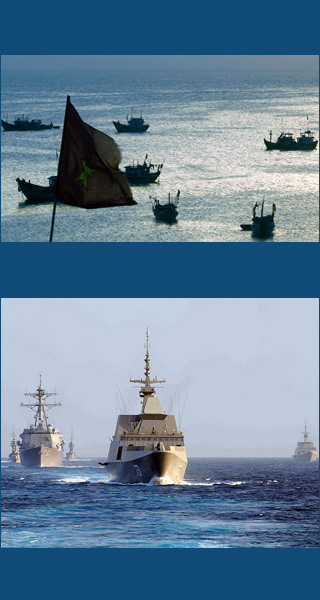To lead on Asian disputes, the US must combine diplomacy and embrace of UNCLOS
 |
| Fishing in troubled waters: Vietnamese fishermen around Chinese-controlled Paracel islands (top); Chinese naval fleet in the South China Sea |
Asia’s maritime disputes primarily consist of three: The South China Sea dispute involves Brunei, China, Malaysia, the Philippines, Taiwan and Vietnam. In 2012, China and the Philippines engaged in a naval standoff over the Scarborough Shoal while Vietnam accused China of cutting the seismic cables of one of its vessels exploring for oil and gas. In the East China Sea, China and Japan, and also Taiwan, are clashing over the Senkaku or Diaoyu Islands. The pendulum has swung in the past two months between talk of a political summit for reducing tensions to the Chinese locking weapons-guiding radar on Japanese ships. In the Sea of Japan, Japan and South Korea are contesting the Takeshima or Dokdo Islands.
| These Asian island disputes have ebbed and flowed for decades….and nationalism plays a role. |
Given this complex backdrop, the Obama administration can engage on these disputes in three ways.
First, it must sustain its intensive diplomacy and emphasis on showing up in the region to ensure, as former Assistant Secretary of State Kurt Campbell noted, that “cooler heads prevail.” This includes encouraging ASEAN and China to conclude a maritime Code of Conduct building on the 2002 Declaration on the Conduct of Parties. While efforts to advance the code ran aground during the November 2012 ASEAN-China Leaders Meeting, with the parties failing to even agree on a regional crisis hotline, picking up this thread must be a key second-term priority.
In addition, the administration should continue to proffer models for joint exploration of resources to encourage thinking beyond traditional notions of sovereignty. One such model is based on the 1920 Spitsbergen Treaty that granted Norway sovereignty over the disputed Spitsbergen archipelago in the Arctic while prohibiting military fortifications and permitting other signatories to undertake mining activities.
| How should the US balance, reassuring its allies and protecting its interests without triggering rumblings of encirclement in Beijing? |
More fundamental are three issues relating to US capabilities and commitments, alongside those posed by sequestration defense cuts. First, how should the US balance, reassuring its allies and protecting its interests without triggering rumblings of encirclement in Beijing? As Secretary of State John Kerry noted in his confirmation hearing, given that “we have a lot more forces out there than any other nation in the world, including China…we need to be thoughtful on how we go forward.” Second, should conflict erupt in Asia’s waters, resulting in US intervention and execution of the new air-sea battle strategy to gain access to an operational area, what political strategy will follow suit to resolve the conflict? Third, how do US treaty obligations relate to these disputes? While Article 5 of the 1960 US-Japan Security Treaty is understood to extend to the Senkakus, the applicability of the 1951 US-Philippines Mutual Defense Treaty to a conflict in the South China Sea is less clear. Internal clarity on US obligations and red lines is thus critical.
Third, the administration must elevate its legal strategy for managing these disputes. Ratification of UNCLOS to which the US de facto adheres is essential, as former Secretary of State Hillary Clinton testified before the Senate last year, to ensure that US navigational rights and its ability to credibly challenge other countries’ behavior are on the strongest legal footing.
| For the US to have the standing to call for a rules-based approach to these disputes, it must adopt UNCLOS. |
Whether other parties bring such claims remains to be seen. Although arbitration offers a clean and contained alternative to fluctuating diplomacy and skirmishes, precluding US “interference” as China desires, China does not view arbitration as a bilateral solution and, moreover, assumes that time is on its side. As such, for the United States to have the standing to call for a much needed rules-based approach to these disputes, it must formally adopt the rules.
Asia’s maritime disputes are a disruptive force for US interests; however, they present an opportunity. A shortsighted view would conclude that the opportunity presented is a strategic opening for the United States and a regional tilt given recent Chinese heavy handedness. The reality is that states in the region have no interest in choosing sides. According to the National Intelligence Council’s Global Trends 2030 report, they will instead increasingly be pulled in both directions: economically toward China and security-wise toward the US. Moreover, given Sino-US economic interdependence, a China that perceives itself subject to containment and doubles down militarily is not in US interests.
The opportunity presented instead is for the United States to demonstrate leadership in the region that combines deft diplomacy, considered military engagement and an adherence to international law as an enabling rather than enfeebling force. Doing so will test its ability to remain an effective Pacific power while navigating the rise of another – all this to preserve an order with which US security and economic interests are inextricably linked in this century.
The writer is an attorney at White & Case LLP and previously served as a White House Fellow in the US Department of Justice and as a national security aide in the US Senate.

No comments:
Post a Comment
Note: Only a member of this blog may post a comment.